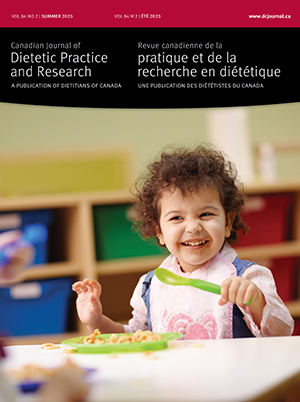Abstract
Purpose: This investigation evaluated food values, food purchasing, and other food and eating-related outcomes during the COVID-19 pandemic in Quebec, Canada. The role of stress in eating outcomes was also examined.
Methods: An online household survey was conducted among Quebec adults aged ≥18 years (n = 658). Changes in outcomes during, as compared to before, the pandemic were evaluated using descriptive statistics and thematic analysis of free text responses. Eating outcomes by daily stress level (low, some, high) were assessed using Cochran–Armitage test for trend.
Results: Most respondents reported increased importance and purchasing of local food products (77% and 68%, respectively) and 60% reported increased grocery spending (mean ± standard deviation: 28% ± 23%). Respondents with a higher daily stress level had a higher frequency of reporting eating more than usual compared to before the pandemic (low stress 21%, some stress 34%, high stress 39%, p-trend <0.0001). Free text responses described more time spent at home as a reason for eating more than usual.
Conclusions: To support healthy eating during and post-pandemic, dietitians should consider patients’ mental/emotional well-being and time spent at home. Moreover, support of local food products may provide opportunities to promote healthy eating, sustainability, and post-pandemic resiliency of food systems.
Résumé
Objectif. Cette enquête a évalué les valeurs alimentaires, l’achat d’aliments, et d’autres mesures liées aux aliments et à l’alimentation pendant la pandémie de COVID-19 au Québec, Canada. L’influence du stress sur l’alimentation a également été examinée.
Méthodes. Une enquête sur les ménages a été réalisée en ligne auprès d’adultes québécois de ≥ 18 ans (n = 658). Les changements dans les différentes mesures durant, comparativement à avant, la pandémie ont été évalués au moyen de statistiques descriptives et d’analyses thématiques des réponses de type texte libre. Les mesures liées à l’alimentation en fonction du niveau de stress quotidien (faible, moyen, élevé) ont été évaluées à l’aide du test de tendance de Cochran-Armitage.
Résultats. La plupart des répondants ont déclaré accorder plus d’importance aux aliments locaux et en acheter davantage (77 % et 68 %, respectivement) et 60 % ont déclaré avoir augmenté leurs dépenses d’épicerie (moyenne ± écart-type : 28 % ± 23 %). Les répondants présentant un niveau de stress quotidien plus élevé étaient plus susceptibles de déclarer qu’ils mangeaient plus qu’à l’habitude par rapport à la période précédant la pandémie (faible stress : 21 %; stress moyen : 34 %; stress élevé : 39 %; tendance p < 0,0001). Les réponses de type texte libre ont révélé que le fait de passer plus de temps à la maison constituait une raison de manger plus qu’à l’habitude.
Conclusions. Pour favoriser une saine alimentation pendant et après la pandémie, les diététistes devraient tenir compte du bien-être mental/émotionnel des patients et du temps passé à la maison. En outre, le soutien à l’égard des aliments locaux pourrait permettre de favoriser une saine alimentation ainsi que la durabilité et la résilience post-pandémique des systèmes alimentaires.



